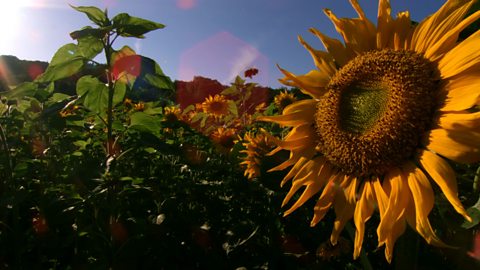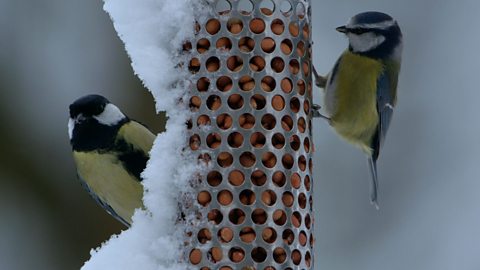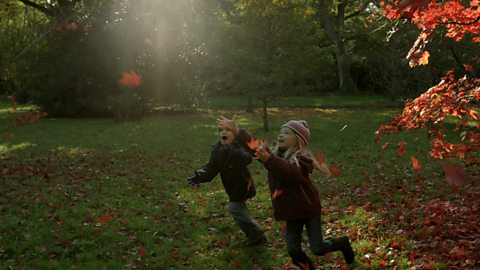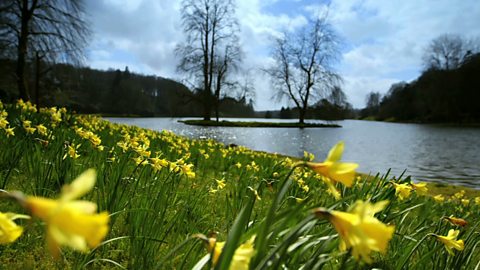Narrator: We all love autumn, don't we? It's the time we celebrate Horrible Halloween and Fantastic Fireworks Night'!
But autumn means winter is on the way. And whilst we're having fun, trees have to get ready for the coming cold snap.
Leaves trap sunlight to make food, in a process called photosynthesis. But, in the winter there's not enough sun for them to work properly.
The trees stop making the green chemical called chlorophyll that captures the sunlight, and the yellow, brown and red colours underneath begin to show.
They look brilliant.
And as they die and fall off they're great fun to catch, kick through and enjoy.
But what happens to them after they've landed on the ground?
Almost one-and-a-half billion trees lose their leaves in our country every year. That's around twenty-five trees for every person living here.
They drop thousands of tons of leaves on the ground.
So, how is it that we don't end up buried in leaves?
It's one of nature's secrets.
[MUSIC: "9 to 5" by Dolly Parton]
Every year, a slimy demolition squad springs into action.
This is one of the key members of the squad. The earthworm!
They love the moist leaves, because they breathe through their skins, and their skins need to be wet to work.
In the autumn they wriggle up from the ground into the piles of damp autumn leaves.
To do lots and lots of eating.
They munch their way through the leaves, breaking them up into smaller pieces.
These then get mixed up with the soil…
making the ground a better place for plants to grow.
Our next demolition agent looks like something you might eat. Mushrooms.
They can't make their own food from sunlight, so they live off things like rotting leaves.
Mushrooms and toadstools spread tiny spores through the air, like seeds in the wind.
But even if they look good to eat, you should never pick wild mushrooms.
Some are so poisonous they could kill even a grown-up.
This is the third and slimiest member of our leaf demolition squad.
This yellow moving goo is called a slime mould.
One sort is called the scrambled egg slime mould, and another the dog's vomit.
For most of the year slime moulds are just tiny blobs, but in autumn they gang together and creep around like a moving carpet.
They haven't got eyes or a nose, but they are really good at finding food, like rotting leaves and other moulds.
This yellow mould has found a white one to eat.
It wouldn't be hard to get out of their way, though. We are watching them speeded up. But really, slime moulds can only move one millimetre an hour.
So, it would take them a whole day and a night to travel the length of your little finger.
When the food runs out they use the same trick as mushrooms. They send lots of tiny spores into the air to make new slime moulds in other damp places.
So, if you take a trip out to see the autumn leaves this year, take a bit of extra time to look for the unsung heroes of the autumn.
The slimy demolition squad!
Video summary
Broadleaf trees lose their leaves in autumn in preparation for winter.
Chlorophyll is the green chemical that captures the sunlight and this breaks down in autumn, showing the other colours underneath.
The leaves fall, thousands of tons of them and three members of a demolition squad break them down.
The first are the earthworms which eat through the leaves and mix them into remains into the soil.
The second group are the fungi which break down the leaves and live off their nutrients.
In the autumn the fungi grow caps which make spores carried by the wind and these spores will grow into new fungi.
The final group are the slime moulds which can gang up together and form a carpet.
They move around the woodland floor, eating the rotting leaves.
When they have eaten all the food they too can make spores which will one day grow into new slime moulds.
This is from the series: The Great British Year
Teacher Notes
As a starting point pupils could list the similarities and differences between the life cycle of the fungi and slime mould.
This clip will be relevant for teaching Science/ Geography.
This topic is suitable for KS1 and KS2 in England and Wales and in Northern Ireland. Also Early and 1st Level in Scotland.
British plants, animals and landscapes through the four seasons. video
Plant and animals respond to the changes in the seasons.

How summer weather affects the behaviour of British animals and plants. video
Wild animals find a variety of abundant summer food sources.

How winter weather affects the behaviour of British animals and plants. video
Winter for animals is not so much fun, and this clip looks at the work animals put in with their continuing quest for food.

What does it take to raise a baby bird? video
Male birds sing to attract a partner and warn other birds away. Then the partner birds team up to incubate the eggs and feed the young.

How autumn weather affects the behaviour of British animals and plants. video
Animals in autumn prepare for winter by storing food, migrating or hibernating.

How spring weather affects the behaviour of British animals and plants. video
Seasonal changes in behaviour of animals and growth cycle of plants in spring time.
